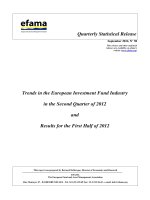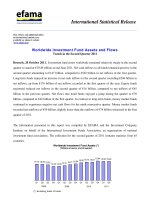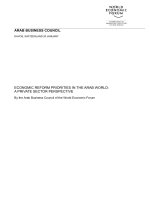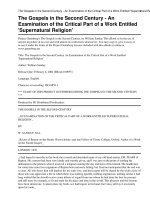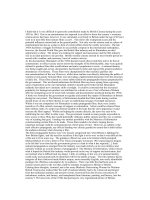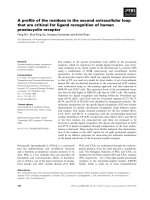War Bonds in the Second World War: A Model for a New Iraq/Afghanistan War Bond? docx
Bạn đang xem bản rút gọn của tài liệu. Xem và tải ngay bản đầy đủ của tài liệu tại đây (117.44 KB, 7 trang )
CRS Report for Congress
Prepared for Members and Committees of Congress
War Bonds in the Second World War: A Model
for a New Iraq/Afghanistan War Bond?
James M. Bickley
Specialist in Public Finance
March 1, 2010
Congressional Research Service
7-5700
www.crs.gov
R41087
War Bonds in the Second World War: A Model for a New Iraq/Afghanistan War Bond?
Congressional Research Service
Summary
The high costs of fighting the wars in Iraq and Afghanistan have rekindled congressional interest
in the concept of the sale of a Treasury security to help finance these war costs. In the 111
th
Congress, three bills have been introduced that would permit the issuance of a war bond: S. 2846,
H.R. 4315, and H.R. 4385.
Although these bills are silent on any relationship between the proposed “war bonds” and World
War II-era war bonds, the question has been raised whether or not the issuance of war bonds
during the Second World War serves as a good model for a new “war bond.”
During the Second World War, war bonds were sold to help finance the cost of national defense.
War bonds were simply a new name for already existing U.S. savings bonds. War bonds were
aggressively marketed through well organized campaigns, which appealed to citizens’ sense of
patriotism. Their primary purpose was to reduce consumer spending in order to lessen
inflationary pressures and black market activity. Also, campaigns to sell war bonds were intended
to raise morale by creating a sense of participation in the war effort. The sale of war bonds did
reduce consumer spending.
Current economic and financial conditions differ from those of the early 1940s. During the
Second World War, high inflation and over-employment prevailed. The federal government
imposed price and wage controls, production controls, rationing, controls on the level of interest
rates on Treasury securities, and regulations on installment loans. As mentioned previously, war
bonds were marketed primarily to reduce consumer spending. Today, despite concern about a
personal savings rate below historical norms, most federal officials are more concerned about
raising consumer spending, because of high unemployment and inadequate aggregate demand. To
date, no savings bond or any other Treasury security issue has ever had its funds earmarked for
any specific purpose; rather, all funds raised have been placed in the general fund.
In summary, the prior war bonds program in the Second World War is a problematic model for
Iraq/Afghanistan “war bonds.” This report will not be updated.
War Bonds in the Second World War: A Model for a New Iraq/Afghanistan War Bond?
Congressional Research Service
Contents
Introduction 1
War Bonds in the Second World War 1
Current Savings Bonds 3
Patriot Bonds 3
Conclusion 4
Contacts
Author Contact Information 4
War Bonds in the Second World War: A Model for a New Iraq/Afghanistan War Bond?
Congressional Research Service 1
Introduction
The high costs of fighting the wars in Iraq and Afghanistan have rekindled congressional interest
in the concept of the sale of a Treasury security to help finance these war costs. In the 111
th
Congress, three bills have been introduced that would permit the issuance of a war bond: S. 2846,
H.R. 4315, and H.R. 4385.
Although these bills are silent on any relationship between the proposed “war bonds” and World
War II-era war bonds, the question has been raised whether or not the issuance of war bonds
during the Second World War serves as a good model for a new “war bond.”
On December 8, 2009, Senator E. Benjamin Nelson introduced S. 2846. On December 15, 2009,
Representative Michael C. Burgess introduced H.R. 4315. On December 16, 2009, H.R. 4385
was introduced by Representative Kendrick B. Meek. All three bills have the short title of
“United States War Bonds Act of 2009” and the official title of “To authorize the issuance of
United States War Bonds to aid in funding of the operations in Iraq and Afghanistan.” All three
bills are similar and state that the authorized war bonds “shall be in such form and denominations,
and shall be subject to such terms and conditions of issue, conversion, redemption, maturation,
payment, and rate of interest as the Secretary [of the Treasury] may prescribe.”
In response to congressional attention, this report describes the use of war bonds during the
Second World War and examines their relevance as a model for new Iraq/Afghanistan war bonds.
This analysis concludes that prior war bonds issued during the Second World War are a
problematic model for a new Iran/Afghanistan “war bond.”
War Bonds in the Second World War
On March 1, 1935, the first savings bonds (Series A) were issued to provide a savings instrument
for small savers and to lower interest costs to the Treasury by expanding the potential market for
Treasury securities.
1
This bond was registered and accrued interest at a fixed rate until redeemed.
Series B, C, and D, which were similar to Series A, were issued subsequently.
Before the Second World War started in Europe, the U.S. economy was still in the Great
Depression; hence, unemployment was high, unused productive capacity was extensive, and
wholesale and retail prices were declining. After war started in Europe on September 1, 1939, the
United States increased defense spending, which was financed by new and higher taxes, cuts in
nondefense spending, and an expansion in the national debt. On March 11, 1941, Congress passed
the “Lend-Lease Act,” which empowered the President to provide defense material to foreign
governments “whose defense the President deems vital to the defense of the United States.”
2
1
U.S. Department of the Treasury, Savings Bond Division, A History of the United States Savings Bond Program
(Washington: September 1984), p. 5.
2
Paul Studenski and Herman E. Krooss, Financial History of the United States (New York: McGraw-Hill Book
Company, Inc., 1963), p. 441.
War Bonds in the Second World War: A Model for a New Iraq/Afghanistan War Bond?
Congressional Research Service 2
Despite higher taxes and cuts in nondefense spending, the large increase in defense-related
spending, plus the absorption of a significant proportion of the manpower pool by the armed
forces, began generating inflationary pressures as unemployment fell and unused plant capacity
diminished. The U.S. government attempted to lessen inflationary pressure by encouraging the
general public to buy savings bonds, which were now called “defense bonds.”
3
On May 1, 1941,
the Treasury issued a new savings bond (Series E). Because of the comparatively high rate
offered on these securities, a limit of $5,000 (maturity value) was placed on the amount one
person could acquire in any one calendar year.
4
After the United States entered the war in December 1941, defense spending soared. Savings
bonds were renamed “war bonds.” During the Second World War, existing taxes were raised, new
taxes imposed, and price and wage controls implemented. In addition, production controls were
instituted and a rationing system established. The production of many consumer products such as
automobiles and refrigerators ended. Controls were imposed on consumer credit and stock market
credit.
5
The Treasury and the Federal Reserve fixed interest rates on Treasury securities at low levels to
reduce interest costs. The Federal Reserve conducted an “easy” money policy; hence, the banks
had plenty of reserves. Although this policy reduced interest costs, it contributed to inflationary
pressures because the money supply expanded.
As war production rose, inflationary pressures increased dramatically. Rising employment and
extensive overtime resulted in surging growth of wage incomes. Despite higher taxes, workers
had more disposable income. In order to assist in lessening inflationary pressures and reducing
black market activity, the War Savings Staff at the Treasury managed a series of eight war loan
drives. Employees were encouraged to purchase war bonds through payroll deduction plans.
While the general population purchased war bonds, the U.S. government decided to promote the
purchase of Treasury market-risk securities (bills, notes, bonds, certificates, and tax notes) to
large individual and corporate investors.
6
These market-risk securities were simply regular
Treasury marketable securities; that is, they were bought and sold on financial markets. Victory
Fund Committees consisting of bankers and members of the securities industry were established
in each Federal Reserve district to assist the Treasury in marketing both war bonds and market-
risk securities, which were called “victory loans.”
7
Henry Morgenthau, Secretary of the Treasury,
combined the War Savings Staff managed by the Treasury and the Victory Fund Committees into
a new organization called the War Finance Division, which reported to the Treasury.
8
From May 1, 1941 through December 1945, the War Finance Division and its predecessors
were responsible for the sale of nearly $186 billion worth of government securities. Of this,
3
U.S. Department of the Treasury, Savings Bond Division, p. 11.
4
U.S. Department of the Treasury, Savings Bond Division, p. 7.
5
Margaret G. Myers, A Financial History of the United States (New York: Columbia University Press, 1970), pp. 333-
359.
6
U.S. Department of the Treasury, Savings Bond Division, p. 15.
7
Ibid.
8
Ibid.
War Bonds in the Second World War: A Model for a New Iraq/Afghanistan War Bond?
Congressional Research Service 3
more than $54 billion was in the form of War Savings bonds. E bonds alone accounted for
$33.7 billion.
9
According to most economic historians, the war loan drives were successful in encouraging the
average worker to purchase war bonds and those with greater financial resources to purchase
victory loans. These sales absorbed potential consumer spending that would have exacerbated
inflation and expanded black market activity. The purchase of war bonds represented much new
net savings because small savers had limited alternative saving instruments.
The war loan drives had a strong patriotic appeal, involved 6 million volunteers, and utilized
extensive donated advertising. Each war loan drive
was a unique fusion of nationalism and consumerism. Seeking to stir the conscience of
Americans, it invoked both their financial and moral stake in the war. The sale of war bonds
provided a way in which patriotic attitudes and the spirit of sacrifice could be expressed.
10
Neither war bonds nor victory loans were earmarked for defense spending. During the Second
World War, however, defense-related spending reached over 90% of federal outlays.
Current Savings Bonds
Currently, Series EE and Series I savings bonds are being issued. Series EE is the dominant
series, as measured by sales. Effective May 1, 2005, Series EE bonds issued on or after May 1,
2005, earn a fixed rate of interest. Interest accrues monthly, compounds semiannually, and is
payable at the time of redemption. The bond owner has the option of either deferring income
taxes on interest earnings until the time of redemption, or paying federal income taxes as interest
accrues.
Series I bonds are securities that accrue earnings based on both a fixed rate of return and a
semiannual inflation rate. A single, annual rate, called the composite rate, reflects the combined
effects of the fixed rate and the semiannual inflation rate. The fixed rate is selected by the
Treasury, is in effect when a bond is issued, and applies until the bond matures. The semiannual
inflation rate reflects the percentage change in the consumer price index for all urban consumers
(CPI-U).
No savings bond issue or any other Treasury security issue has ever had its funds earmarked for
any specific purpose; rather, all funds raised have been placed in the general fund.
Patriot Bonds
After the terrorist attacks of September 11, 2001, both houses of Congress considered and passed
differing measures authorizing the sale of so-called war bonds to help give the public a greater
sense of participation in the war effort and to provide revenues that could be earmarked for
9
Ibid.
10
War Bonds (Loans), World War Two Advertising History, A project of the Digital Scriptorium: Rare Book,
Manuscript, and Special Collections Library, Duke University.
War Bonds in the Second World War: A Model for a New Iraq/Afghanistan War Bond?
Congressional Research Service 4
disaster relief and anti-terrorist actions. On December 11, 2001, the Department of the Treasury
designated Series EE savings bonds as “Patriot Bonds,” whose purpose was “to fight the war on
global terrorism.”
11
The only change, however, was to print the words “Patriot Bond” on the
Series EE bond.
12
Conclusion
Economic and financial market conditions today differ so much from those of the Second World
War that the prior war bond model is problematic for a new “war bond” debt issue.
The present economy is vastly different from that of the Second World War, which had high
inflation and over-employment. During the Second World War, the U.S. government imposed
extensive controls on wages, prices, and credit. War bonds were then marketed to reduce
consumer spending. The current economy, however has a low rate of inflation and high
unemployment. No controls exist on prices, wages, production, interest rates on marketable
Treasury securities, or installment loans. No goods and services are rationed. Instead of
attempting to reduce consumer spending, federal officials are concerned about increasing
consumer spending.
Today, the U.S. financial system is more complex, sophisticated, diverse, and deregulated than in
the Second World War era. Small savers have an array of savings vehicles. For example, they can
invest in money market funds and certificates of deposit (CDs) of financial institutions. Today,
savings bonds are almost always a substitute mechanism for other forms of personal savings.
Author Contact Information
James M. Bickley
Specialist in Public Finance
j
ov
, 7-7794
11
U.S. Department of the Treasury, “Treasury Department Unveils Patriot Bond on Anniversary of September 11
Attacks,” Treasury News, December 11, 2001, p. 1.
12
U.S. Department of the Treasury, Questions and Answers about Series EE Patriot Bonds, December 2001, p. 1.



